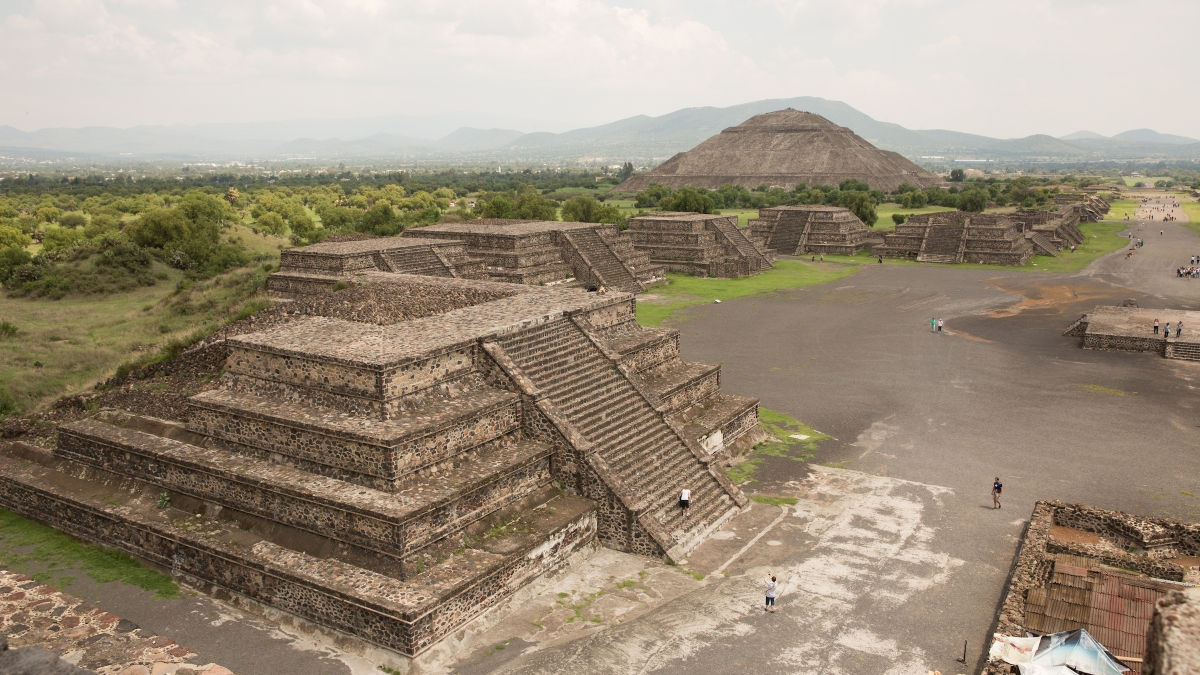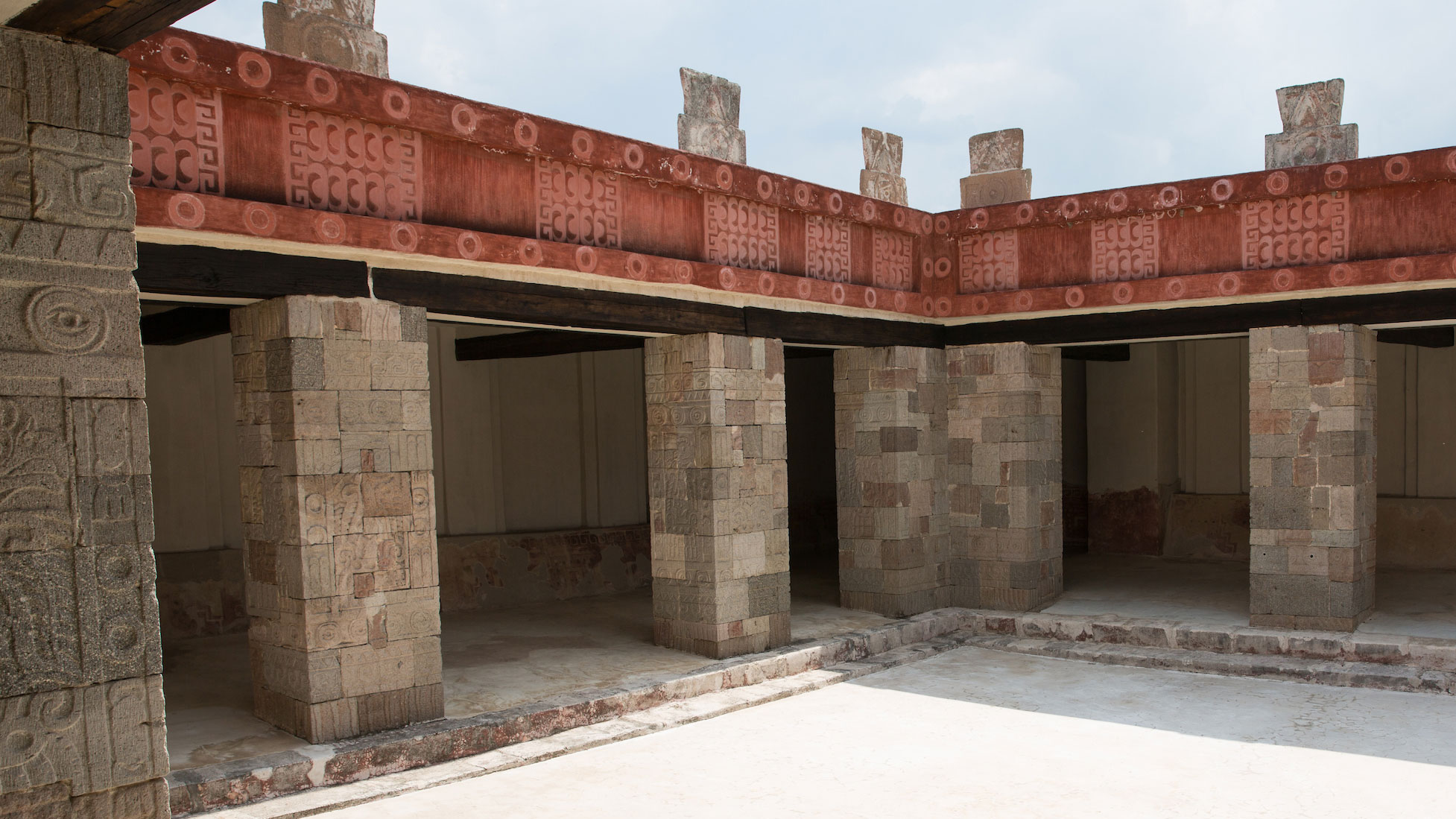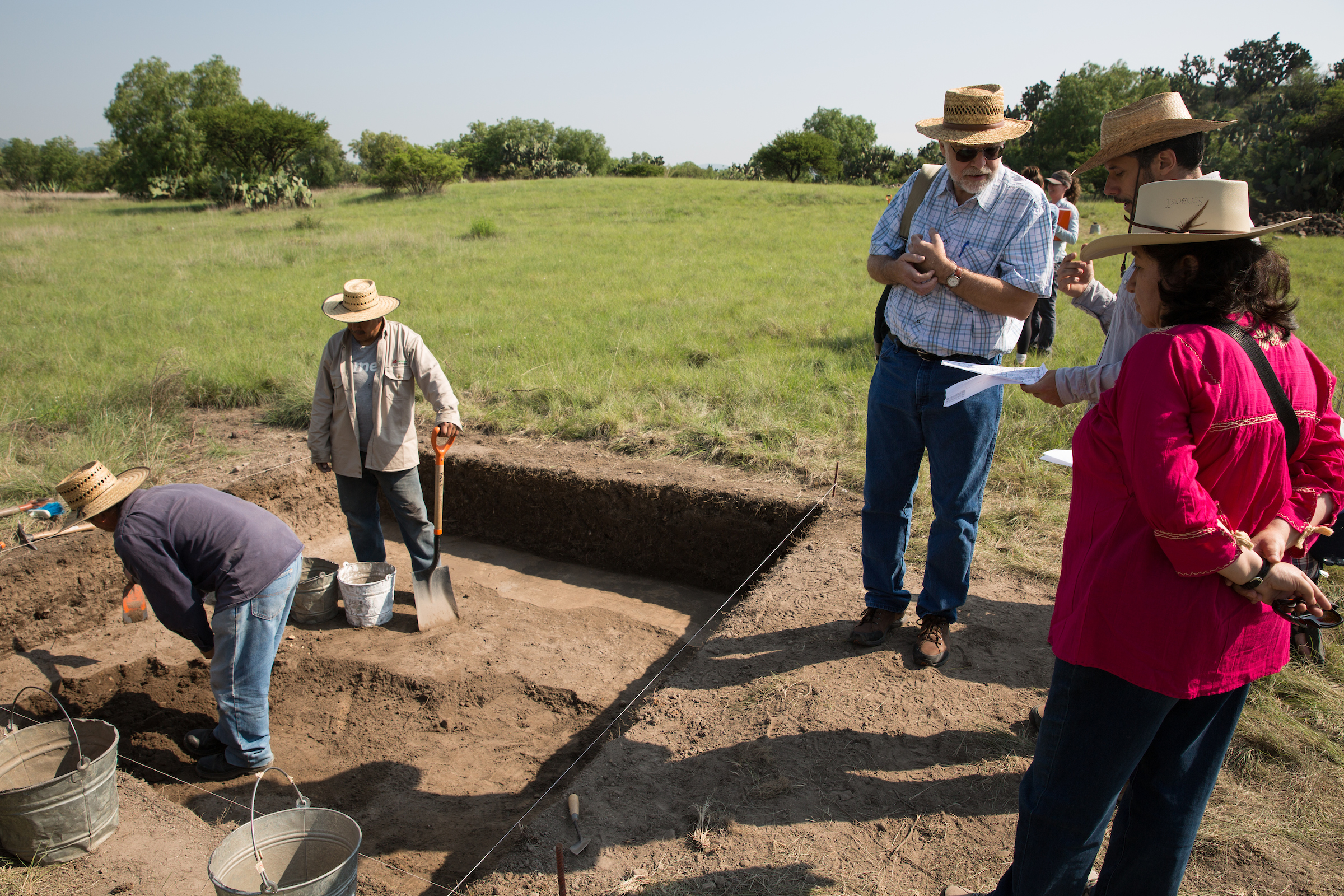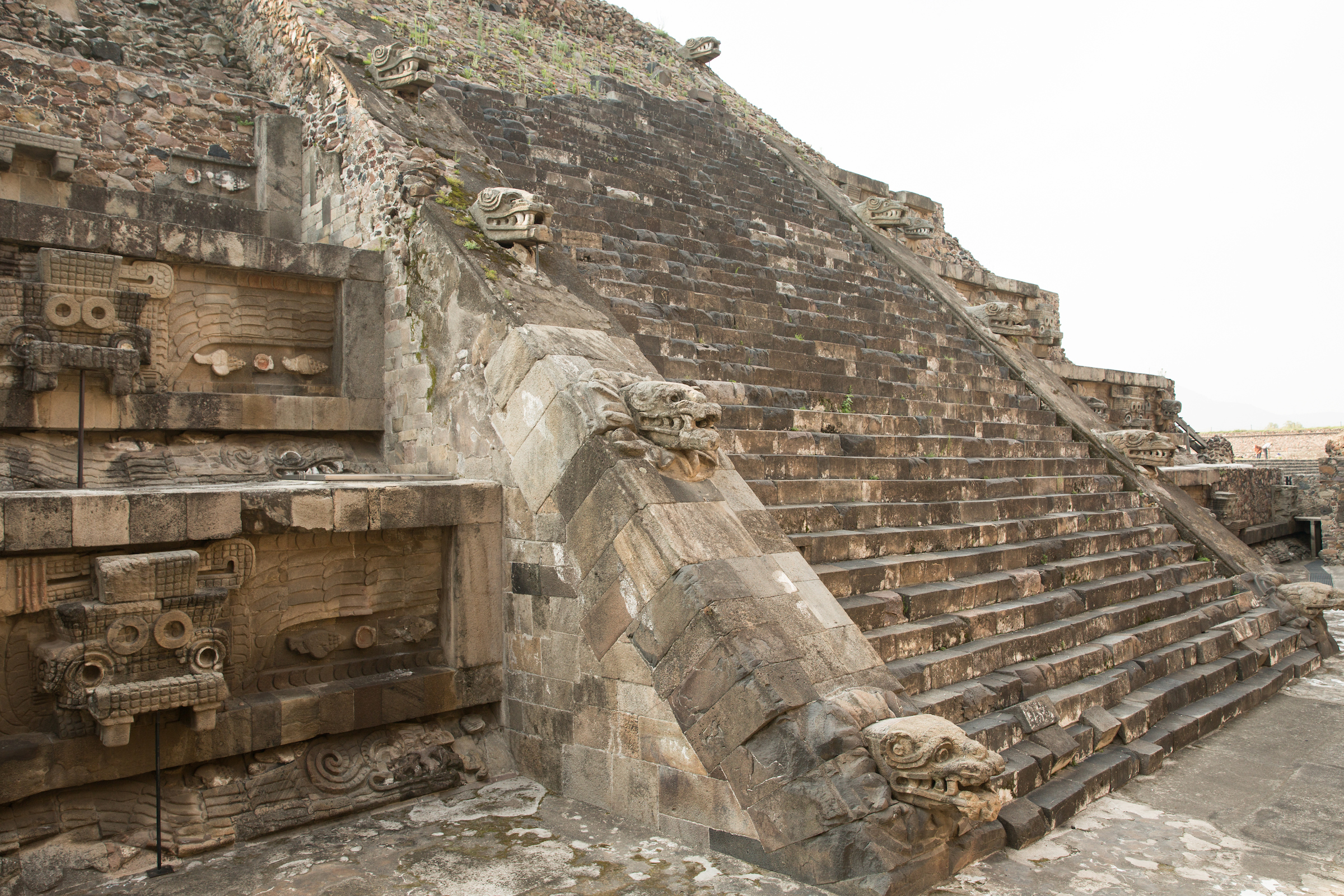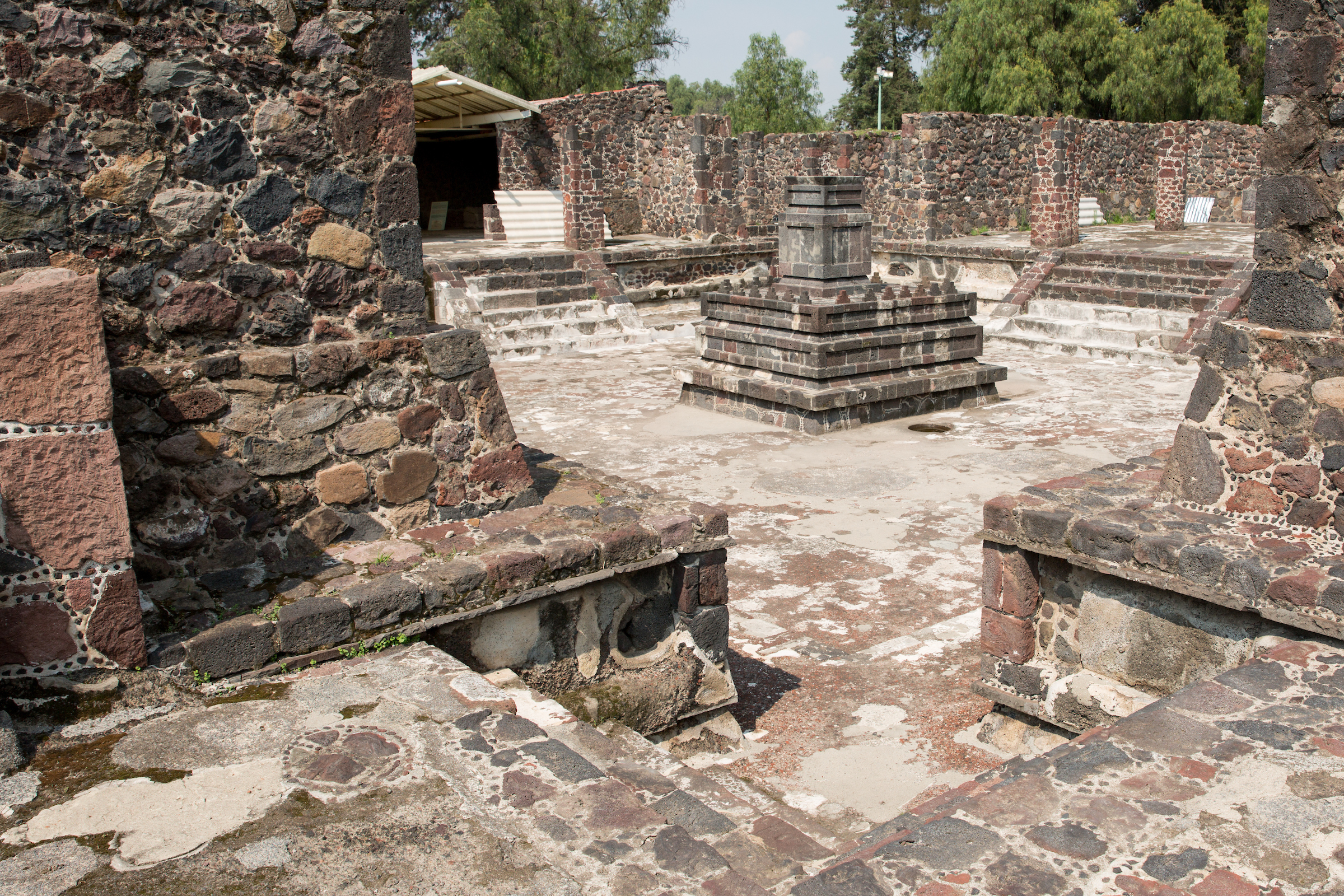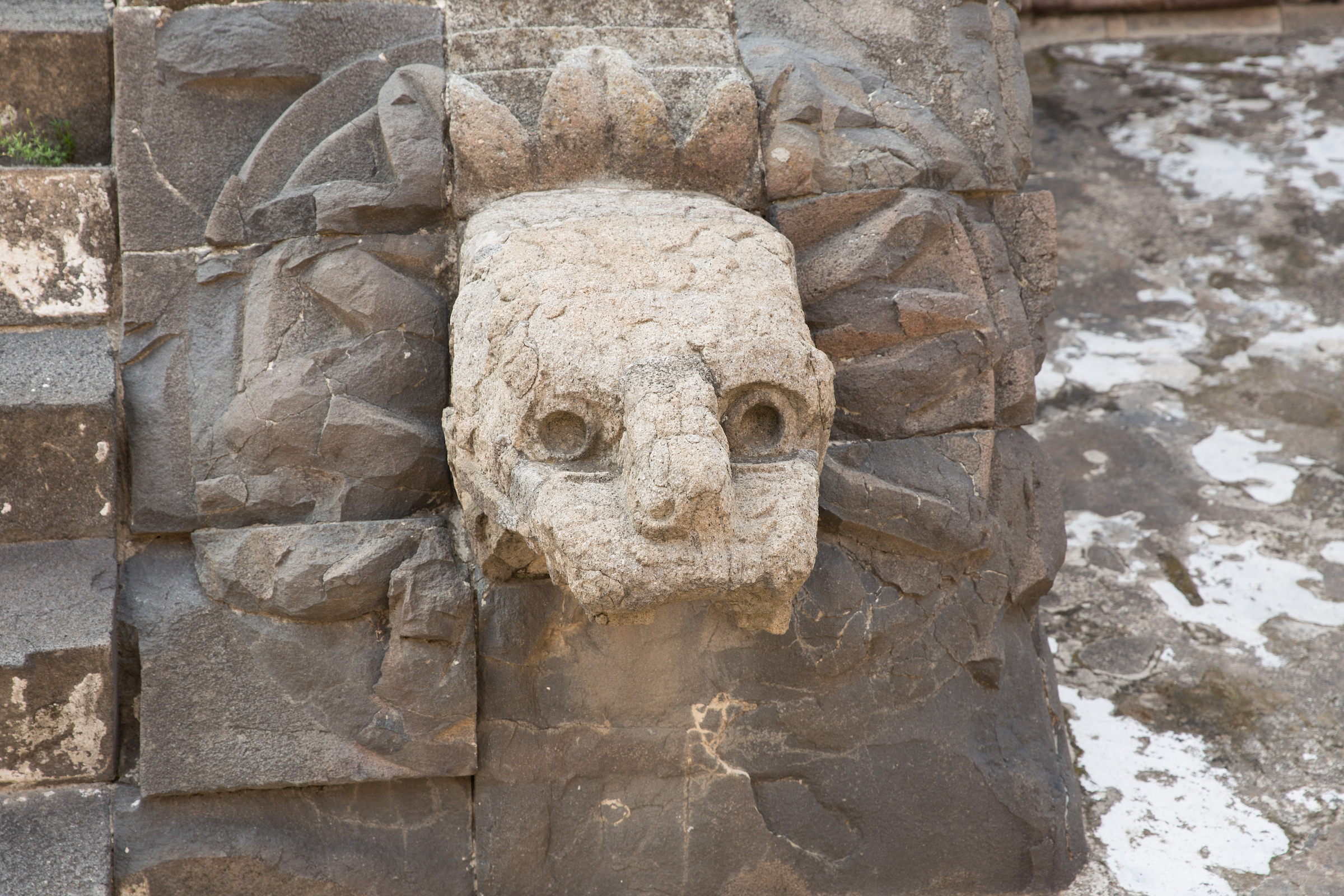This is the first in a three-part series on ASU’s archaeology lab in San Juan Teotihuacan, Mexico. Click for the second and third installments. Lab director Michael E. Smith will appear Wednesday in Tempe to talk about new discoveries; find event information at the bottom of this story.
Archaeology, at its heart, is about people. People who lived a very long time ago, and lived somewhat differently than us, but people nonetheless. They had bad days. They broke things. They owned pets.
So, although this is a story about a university’s archaeology lab at one of the greatest cities of the ancient world, it’s also a story about people, and the people who study them.
Life in the ancient world’s biggest city
It’s A.D. 200. You are a Teotihuacano. You live in the first and biggest city in the Western Hemisphere in what is now central Mexico. A few Chinese cities rival your city’s size, but otherwise it’s the biggest city in the world at the time. You’re one of about 80,000 residents.
You live in a beautiful apartment. The floors are whitewashed with lime plaster. The walls are painted in red murals; jaguars prowl along the base, while priests wearing animal masks are symmetrically depicted above. Ceramic or stone roof ornaments called almenas decorate your rooflines, letting everyone know how well off you are. The apartments have porches open to the mild climate, and you spend most of your time outside. The porches have drains for the rainy season. Your extended family lives in adjacent apartments.
You have nice things that people living out in the countryside don’t have access to or can’t afford: intricately painted fine pots, obsidian knives sharper than surgical steel, carved masks, seashells. Your clothes are cotton. You have never seen metal. For minor ceremonies, religious or civic or both, you gather at a small neighborhood temple in the center of your apartment complex.
Patio of the Palace of Quetzalpapalotl at Teotihuacan. The name Quetzalpapalotl is Nahuatl for the "Quetzal butterfly," and it was applied to this building because of carved images that appear on the columns surrounding the courtyard. Ornaments called almenas mark the roofline. This and top photo by Ken Fagan/ASU Now
If you are a man, you walk outside the city to farm. If you are a woman, you stay home, watch the kids and ugly hairless dogs, tend the turkeys in their pens, cook on a three-pronged burner something like a hibachi, and do other domestic chores. Most of your days are spent in your neighborhood.
Every so often you go downtown for a big ceremony involving the Storm God or the Feathered Serpent at the pyramids. Sometimes the priests sacrifice wild animals like eagles, pumas, jaguars, wolves and rattlesnakes. Sometimes they sacrifice people. You don’t know, because that’s not something you’re involved with at all; the elites and the priests manage all that. Sometimes you go to visit the huge central marketplace on the Street of the Dead, where you can find interesting things that have come from the coasts or the southern jungles. Whatever you’ll find down there was carried there by people. There are no pack animals or wheeled carts. Without navigable waters, there aren’t any boats either.
Your nearest neighbors, the Mayans, think you are the coolest people ever. They copy your clothes and your architecture, and tell everyone they are related to you.
They think you’re so cool they continue to copy you for two centuries after you’ve disappeared.
The big questions
That’s what archaeologists, students, and visiting scholars see when they come to work at Arizona State University’s Teotihuacan Research Laboratory in the adjacent village of San Juan Teotihuacan.
It’s the only foreign archaeological research lab on site, and for the past 30 years it has been used by scholars from all over the world. They come to find answers to the following questions:
If cities have never existed before, why do you build one? If people have never lived in cities before, what compels them to move to one, and stay there? What language did the Teotihuacanos speak? What form of government did they have? Who organized and ran civic life? How did they live so well? And what happened to them?
At Teotihuacan, there are more mysteries than answers. The city’s name means “Place of the Gods” in Nahuatl, the Aztec language.
It’s a great place to be an archaeologist.
First impressions
The ceremonial core of the city was meant to wow, and 1,500 years later, it still does. The Pyramid of the Sun is 21 stories tall. The Pyramids of the Moon and the Feathered Serpent are smaller, but not by much.
The Street of the Dead runs for a mile and a half. Temples line the street. Everything is orderly; the Teos loved symmetry. The pyramids and temples were plastered and painted back in the day, adding to the impact.
ASU professor Michael E. Smith has directed the lab since 2015. He first came to Teotihuacan as an undergrad in 1974 with ASU professor emeritus George Cowgill, who studied the city for 50 years and is regarded as the world’s authority on it. He — and ASU — took over the facility in 1986.

At the end of the Street of the Dead rises the Pyramid of the Moon at Teotihuacan.
Photo by Ken Fagan/ASU Now
Smith, who is part of ASU’s School of Human Evolution and Social Change in the College of Liberal Arts and Sciences, entered archaeology somewhat by accident.
As a student, he floated from major to major until he read one of those pop books about aliens and ancient civilizations popular in the ’70s. It theorized that the Mayans were descendants of Atlantis. Despite learning this was not the case, he remained intrigued with archaeology. It’s not a story he told to peers until recently.
“I remember the first time coming to the zone, coming out of the village, rounding that turn, and the highway is going straight east to the Pyramid of the Sun — just seeing that pyramid looming up above the road,” Smith said.
“You’re not even here yet. Then you go through the entrance and you pay your fee and you get to the Street of the Dead and you look north and south and you just see these ruins going on for miles. The scale is incredible. I’m still awed by the scale of the place. ... Just seeing it for the first time is quite an impression.”
The coolest people in Mesoamerica
People have known about Teotihuacan for a long time. When the Aztecs came along about 1,000 years after the city’s collapse, it was in ruins. They were the first people to excavate at the site. An Aztec emperor sent people out to dig, and they found pots and objects. They took them back to their city and used them in burials and offerings.
Back during its heyday, from A.D. 100 to 600, Teotihuacan was very influential.
“Other groups in Mesoamerica, including the Maya, knew about Teotihuacan, and they copied Teotihuacan style,” Smith said. “Teotihuacan was cool. That’s what was hip in Classic period Mesoamerica. The Maya started doing this, and they all wanted to be Teotihuacan hipsters. These were the kings of powerful Maya states.”
It was like people wanting to copy the latest styles from New York. Mayan kings adopted Teotihuacan clothing styles like the “Balloon Head Dress” and the “Fuzzy Knee Band.” They copied the architectural styles. The king of Tikal built a little platform on the edge of his palace in Teotihuacan style.
“He was saying, ‘I am connected to Teotihuacan,’ ” Smith said.
It got to the point where several people usurped their way into Mayan dynasties, claiming they were from Teotihuacan.
“This was giving themselves legitimacy,” Smith said. “In a couple of cases we’ve proved ‘No, they weren’t,’ because we can tell from the bone chemistry they did not grow up here in central Mexico. But they used the prestige of Teotihuacan to help their claims to the Maya kingdom.”
And they kept on copying the cool people for 200 years after the Teotihuacanos disappeared, until the Mayan civilization collapsed.
“The prestige of Teotihuacan survived centuries after it collapsed,” Smith said.
Video by Ken Fagan/ASU Now
No king: The big mystery of Teotihuacan
Archaeologists know a lot about Teotihuacan: how big it was, when it was founded and collapsed, where everyone lived, and the main temples and buildings.
The biggest mystery they don’t have an answer for is: Where’s the king? They haven’t found anywhere luxurious enough to be a royal palace. This alone makes Teotihuacan radically different from other ancient cities and societies. How was society organized? How were the pyramids built, if there was no powerful pharaoh figure pointing a bejeweled finger and saying, “Do it”?
In Smith’s experience, people studying Aztec or Mayan sites don’t sit around scratching their heads saying, ‘Was there a royal palace here?’
“We know exactly where the royal palace is,” he said. “It’s the easiest building to find. At Teotihuacan, we don’t know. Why is that? Some people just think we haven’t found the palace. We haven’t found the king of Teotihuacan.
“Other people — including me — think maybe there wasn’t a king. Maybe this site was more of a collective government. Maybe people had more of a say, and there wasn’t one guy ruling over everything. That would be sort of bizarre. ...
“How did they manage to be successful for centuries? They grew pretty rapidly, and then for centuries just did very well, were successful, and then they collapsed. How was life organized? What was life like for people? I think that’s the big mystery of Teotihuacan.”
Challenge for the future
How do you get 80,000 people to buy into building pyramids and a city? Archaeologists don’t really understand that. One approach in archaeology is to study temples and palaces and pyramids. The other is what is called household archaeology — how did everyday people live?
“Ideally there are two approaches,” Smith said, “and that’s what we have here.”
The latest work done by ASU at Teotihuacan combines a look at the apartment complexes where people lived, along with the civic buildings and temples along the Street of the Dead and the ceremonial area at the Plaza of the Columns.
“Looking both at the central architecture and the big structures and the residences might allow us to figure out how this city worked,” Smith said. “They were doing something right, and to try to figure that out through excavation, through mapping, through artifact analysis, I think that’s the challenge for the future.”
Plaza of the Columns
Out in a field east of the Pyramid of the Sun sits the Plaza of the Columns. It’s where David Carballo — a visiting scholar and assistant professor of archaeology at Boston University — is digging today. There are two 12- by 12-foot pits in a grassy pasture dotted with trees and stands of nopal cactus.
Why is it called the Plaza of the Columns?
“Who knows why,” said Carballo, a soft-spoken man with movie-star looks. “There aren’t any columns.”
He is excavating out-of-the-way areas in the Plaza of the Columns, a palace or civic ceremonial complex that “I think might be economically significant for the sorts of production that might underlie a palace complex, if this is actually a palace complex,” Carballo said.
From right: Oralia Cabrera Cortes, director of operations at the ASU Teotihuacan Research Laboratory; David Carballo of Boston University; and ASU professor and lab director Michael E. Smith of ASU being done at the Plaza of the Columns. Photo by Ken Fagan/ASU Now
It’s near the three biggest temple mounds outside the pyramids — it would have been a busy place. Carballo is interested in the political economy of Teotihuacan. Out here you’d find craft production and commerce.
“We’re not expecting anything sexy like tombs,” Carballo said.
He’s looking for micro-artifacts, like stone chips or turkey eggshells.
“Even though they look like clean floors, they could have had a lot of activity,” he said.
Carballo doesn’t expect to find a knife; he expects to find the remains of knife production (or pottery, or food, or whatever).
“The reason I’m interested in this area is the complex as a whole could have been used for religious reasons,” said Carballo. “I’m interested in seeing how these two interacted with each other.”
Shovel bumming
Carballo’s dig is one of about a half-dozen in the same area. About 100 yards away from his two pits, five workers and a government archaeologist are excavating one of the temple mounds.
The land undulates because it’s covering walls and steps and other structures. Dig sites (random to you, carefully chosen by archaeologists) are each accompanied by a rubble pile and a dirt pile where everything is sifted through screens. Under the nearest shade at each site sit tables with water jugs, gear, instruments, lunch and the diggers’ bicycles in neat stacks.
Part of the puzzle of Teotihuacan is that the Aztecs lived around it (their pottery turns up) and then modern people lived and farmed amongst the ruins, taking stone blocks to build their own homes and whatnot. Some sites are partially destroyed and you’ve got to figure out whether a particular site is worth excavating or not.
“It varies quite a bit from place to place,” Smith said.
There’s only so much time (and money) in a season. In an embarrassment of riches such as this, one of the toughest choices is where to dig next. And archaeologists are like badgers; they’re happiest when they’re digging.
“You can never do as much excavation as you’d like,” Smith said.
Searching for a velvet rope
Nawa Sugiyama, an assistant professor in the sociology and anthropology department at George Mason University, is part of the Plaza of the Columns Project with her father, Saburo Sugiyama, an ASU research professor.
Nawa (“It comes from the Nahuatl, from my dad. It’s pretty dorky”) graduated from ASU in 2006. She did a doctoral dissertation on animals sacrificed at Teotihuacan. Her body language is reminiscent of John Wayne; she has a bit of a swagger.
“We are right in the middle of the ceremonial center of Teotihuacan itself,” she said. It’s a huge plaza, bigger than the Pyramid of the Sun plaza. “This was a public area. ... We’re interested in this area because we’re interested in how Teotihuacan was governed. What brought people here to the ceremonial center? Who organized the construction?”
She is excavating a series of pits delineating a wall. What will this tell researchers? How exclusive the area was. Was there one door open only to elites — a velvet-rope-and-bouncer situation — or a series of doors where, as Smith puts it, “any old trinket vendor could walk in”?
“We’re interested in how the Teotihuacan state was governed,” Sugiyama said. “We want to understand how and who were the people who governed, where they lived, what activities they were involved with, if they had any access to labor in different ways, was it ceremonial. What are the things that brought the population here to the ceremonial center? Who were the ones organizing the labor?
“In order to answer those questions, we really need to understand who the people were. The best place to look is where palatial complexes are, because that’s where the people making the decisions are residing.”
The Teotihuacan Mapping Project
Because of its combination of scale and detail, the Teotihuacan Mapping Project is the one of the best maps of any ancient city. It shows where artifacts were found, leading to an understanding of how the city functioned. Archaeologists call it “indispensable” for planning work at the city.
“Very few ancient cities are mapped to the extent Teotihuacan is,” Smith said.
The grand staircase of the Temple of the Feathered Serpent features sculptured heads including the feathered serpent, Quetzalcoatl. Photo by Ken Fagan/ASU Now
It was initiated by professor René Millon of the University of Rochester, who directed the detailed mapping of the entire city in the 1960s, combining air photos and mapping with surface reconnaissance of more than 5,000 buildings, making notes on visible features, and collecting nearly a million pottery fragments and other ancient objects from the buildings.
The bulk of the material at the lab is that collection. Smith has been using it in his current research for the past few years. He called it one of the “most important collections of artifacts anywhere for the ancient world.”
“It seems to me there’s a heck of a lot that can be learned by studying what’s already been excavated,” he said.
The good life at Teotihuacan
Smith wanders from room to room in an apartment complex named Atetelco: “On the stone wall next to the water.”
The complex is a series of residential courtyards painted in elaborate symmetrical red and white murals of jaguars and priests wearing animal masks. The floors were plastered in imported white limestone. Out in the main plaza sits an elaborate miniature temple. People lived here about A.D. 300 to 500.
The answer to many questions about Teo is “We don’t know.”
“Why they had these really nice murals, they may have been priests or something,” Smith said. “We don’t know.”
“The houses here are quite luxurious,” he said. “It’s amazing how large and well-appointed the houses are. These aren’t the houses of the elite; these are the houses of everybody, the houses of the common people. There are thousands of them, and they’re all very luxurious.
“If one of these Teotihuacano houses — where common people lived — showed up at an Aztec site I was excavating, I’d say for sure this is an elite residence, because it would be bigger and fancier than most Aztec houses.”
Smith thinks the key to understanding how commoners were so well-off economically lies in Teotihuacan’s apartment complexes because they give clues to how people lived at the time. There are five or six completely excavated, like Atetelco, and about 60 partially excavated.
Smith’s current project is putting together a database of all the excavated residences. He is measuring room sizes and patio layouts and amenities like murals. There is a lot of information from excavations that haven’t been fully investigated. Smith feels more can be learned from existing excavations than going out and digging another one.
“We’re trying to find out just how standardized were these residences,” he said. “How big were they? Were the ones on the Street of the Dead fancier than the ones which weren’t on the Street of the Dead?”
An elaborate miniature temple sits in the middle of a Teotihuacan apartment complex named Atetelco: “On the stone wall next to the water.” Photo by Ken Fagan/ASU Now
Another project of his is studying almenas. Almenas were a decorative element that ran along rooftops. The Teotihuacan Mapping Project collected almost 800 of them. Wealthier houses were more likely to have almenas than poorer households. But quite a few of the poorer homes had them, too.
“Even the poorest houses — quite a few of them — had some almena fragments,” Smith said. “This wasn’t limited to the wealthiest. That suggests something about the nature of wealth and equality and classes — that the wealthy weren’t the only ones with fancy things. ... That’s bizarre.
“Most ancient societies — anything I’ve read or studied about — had a small elite and everyone else were commoners. It’s the 5 percent versus the 95 percent. Here, everyone was doing really well.”
Too many tacos to go
Hearths have never been found in the apartments. One archaeologist suggested in the 1950s that rural people prepared food and brought it into the city.
“Think about that,” Smith said. “Eighty thousand people. That’s a lot of tacos to go. They would have needed more than Taco Bell. That’s a ridiculous explanation.”
They had little hibachis — three-pronged burners. The cooking pot sat on top. They could be moved from room to room.
“They cooked right in these houses,” Smith said.
He sits on a wall and imagines the same sunny summer morning in A.D. 300.
“There would be kids,” he said. “There would be these ugly Mexican hairless dogs running around. Turkeys. Some of the compounds they found areas where they kept turkeys. Most days places like this would have been mostly women and children, because the men were farmers. They would have walked out to their fields.”
(The Teotihuacanos were urban farmers. Much as your local hipster would like you to think otherwise, urban farming is not a new thing. Far from it.)
There were ethnic neighborhoods. There was a merchants’ barrio, with lots of pottery from all over Mesoamerica, and circular warehouses for storing goods.
“Certain kinds of artifacts are concentrated in certain areas,” Smith said. “Most life probably took place in the neighborhoods. …
“They went out to farm, but they stayed in their neighborhood to go to the marketplace or attend a ceremony. Periodically they’d go downtown and witness a ceremony at the big pyramids or go to the main marketplace near the Street of the Dead.”
Mesoamerican urban planning
All of Teotihuacan is laid out in a highly organized orthogonal grid. Carballo has been digging at Teotihuacan for 17 years.
“I know if it’s oriented to what I reckon to be the city’s grid system, I’m going to find walls that are running parallel or perpendicular to the grid that I established,” he said. “In that way Teotihuacan is very predictable.”
Most ancient cities were concentrically arranged. In the center were the pyramids, big temples, and huge public spaces. Immediately outside the center (but next to the action) lived the elites, with elaborate murals and houses. Beyond that, on the periphery, houses were made of stone, with much less plaster than the elites had in their houses.
“Think about schlepping in a mile every day to go to the market or to watch a ritual at one of the pyramids,” Carballo said. “It’s another level of housing, but they’re still plugged into this regional economy.”
A carved head of a plumed serpent sits to the side of the main staircase up the Temple of the Feathered Serpent at Teotihuacan. Photo by Ken Fagan/ASU Now
Teo’s apartment compounds were really unparalleled in the ancient world, and they were the dominant housing type. Ancient Rome had apartments too, but they were far inferior to Teo’s. They also weren’t the dominant housing type.
“Maybe part of it is in an apartment you can get economies of scale,” Carballo said. “You can get people learning a trade, passing it on to the other younger generations, and create efficient means of production in a household that’s really big, or a set of cooperating households in these apartments.”
Bigger neighborhoods would be more efficient to tax as well.
People still migrate to cities today. They are one of the main forces of migration. People are drawn to cities for having more economic activities and for having more things to do. That seems to go way far back, Carballo said.
“Here at Teotihuacan we certainly have evidence people are migrating to the city for an economic livelihood,” he said. “This is the first megacity of the Americas. You had a population cracking 100,000 as a whole. We would classify it as cosmopolitan.
“There are multiple languages being spoken here. It’s a diverse place, and I think it has lessons to teach us in the present when we still have multiethnic cities with people migrating to them.”
The Plaza of the Columns excavation is co-sponsored by ASU. The major grant is from the National Science Foundation, to ASU research professor Saburo Sugiyama, and is run through ASU. The excavation is co-sponsored by INAH in Mexico. Saburo Sugiyama and Veronica Ortega are co-directors, and Nawa Sugiyama and David Carballo are in charge of particular excavations programs within the larger project.
Hear Smith speak in Tempe
What: "New Views of the Ancient City of Teotihuacan" lecture.
When: 6-8 p.m. Wednesday, Aug. 31.
Where: Alumni Lounge (Room 202), Memorial Union, Tempe campus.
Details: Free and open to the public. Find more at the events site.
More Science and technology

Applying AI to microelectronics manufacturing
Rivers flow across the planet’s surface, carving deep valleys and intricate canyons. Likewise, makers of microelectronics direct plasma, an ionized gas, to travel over silicon wafers, etching…

Applied Materials invests in ASU to advance technology for a brighter future
For nearly 60 years, global giant Applied Materials has been hard at work engineering technology that continues to change how microchips are made.Their products power everything from flat-panel…

Meet ASU engineering students who are improving health care, computing and more
Furthering knowledge of water resource management, increasing the efficiency of manufacturing point-of-care health diagnostic tools and exploring new uses for emerging computer memory are just some…


